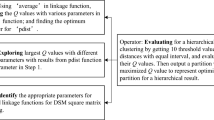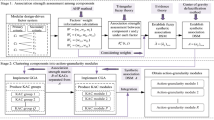Abstract
Designing modular products can result in many benefits to both manufacturers and consumers. The development of modular products requires the identification of highly interactive groups of elements and arranging (i.e., clustering) them into modules. However, no rigorous clustering technique can be found in engineering design literature. This paper uses the design structure matrix (DSM) to visualize the product architecture and to develop the basic building blocks required for the identification of product modules. The DSM architectural representation and building blocks are then used for the development of a new clustering method based on the minimum description length (MDL) principle and a simple genetic algorithm (GA). The new method is capable of partitioning the product architecture into a set of modules where interactions within modules are maximized and interactions outside modules are minimized. We demonstrate the proposed clustering method using several examples of real complex products and compare our results to clustering arrangements proposed by human experts. The proposed method is capable of mimicking the clustering preference of human experts and yields competitive clustering arrangements.






















Similar content being viewed by others
Notes
Webster’s dictionary defines the noun “module” as “a compact assembly functioning as a component of a larger unit‘’.
In a graph, nodes represent product components and edges represent relationships between these components.
For a comprehensive review of product modularity methods, we refer the refer the reader to Gershenson et al. (2004).
A function structure is an input-output diagram of what a product does.
In contrast to the standard approach of adding/substituting modules to produce product variants, this approach to product family design calls for the development of common product platforms that can be “stretched” or “scaled” in one more dimension to satisfy a variety of market requirement (Simpson et al. 2001).
There are different ways of building a DSM. For a full description, please refer to the DSM website at http://www.DSMweb.org.
It worth noting that “partitioning” of DSMs is different than “clustering” (Yassine and Braha 2003). Although both methods rely on re-ordering DSM elements, the objectives are different. In partitioning, the objective is to remove feedback marks from the DSM by making the DSM lower triangular (McCulley and Bloebaum 1996). In clustering, we do not care about feedbacks and DSM marks’ location above or below the matrix diagonal is immaterial.
These marks may constitute the interface between the two product modules.
The relationship can be representing a flow of mass, energy, information, or force/geometrical constraint between the parts.
Here, the model means a description that specifies which node belongs to which cluster. This can be a graph or its DSM representation.
Here we use weighting in order to match the preference of human experts. This becomes more evidential in the case study.
The number of possible product architectures for a system with n elements without cluster overlaps is: \(\sum\nolimits_{i=1}^{n} C_{i}^{n}=2^{n}-1\)
The program is written in C++. It takes about a day to obtain results for a (60 × 60) DSM, on an AMD AthlonTM XP 2500+ machine.
References
Alexander C (1964) Notes on the synthesis of form. Harvard Press, Boston
Anderberg M (1973) Cluster analysis for applications. Academic, New York
Baldwin C, Clark K (2000) Design rules: the power of modularity. MIT, Cambridge
Barron A, Rissenen J, Yu B (1998) The MDL principle in coding and modeling. IEEE Trans Info Theory 44(6):2743–2760
Broyden CG (1965) A class of methods for solving nonlinear simultaneous equations. Math Comput 19(92):577–593
Bui T, Moon B (1996) Genetic algorithm and graph partitioning. IEEE Trans Comput 45(7):841–855
Eppinger SD (2001) Innovation at the speed of information. Harv Bus Rev 79(1):149–158
Eppinger SD, Whitney DE, Smith RP, Gebala D. A. (1994) A model-based method for organizing tasks in product development. Res Eng Des 6(1):1–13
Fernandez C (1998) Integration analysis of product architecture to support effective team co-location, Master Thesis, Massachusetts Institute of Technology, Cambridge
Gaertler M (2002) Clustering with spectral methods. Masters Thesis, Universitat Konstanz, Germany
Garey M, Johnson D, Stockmeyer L (1976) Some simplified NP-complete graph problems. Theor Comput Sci 1(3):237–267
Gershenson JK, Prasad GJ (1997) Modularity in product design for manufacturing. Int J Agile Manuf 1(1):99–109
Gershenson JK, Zhang Y, Prasad GJ (2003) Product modularity: definitions and benefits. J Eng Des 14(3):295–313
Gershenson JK, Zhang Y, Prasad GJ (2004) Product modularity: measures and design methods. J Eng Des 15(1):33–51
Glover F (1989) Tabu Search – Part I. Operations Research Society of America (ORSA). J Comput 1(3):190–206
Glover F (1990) Tabu Search – Part II. Operations Research Society of America (ORSA) J Comput 2(1):4–32
Goldberg DE (1989) Genetic algorithms in search, optimization, and machine learning. Addison-Wesley, New York
Gonzalez-Zugasti J, Otto K, Baker J (2000) A method for architecting product platforms. Res Eng Des 12(2):61–72
Hansen P, Jaumard B (1997) Cluster analysis and mathematical programming. Math Program 79:191–215
Harik G, Cantú-Paz E, Goldberg DE, Miller BL (1997) The Gambler’s ruin problem, genetic algorithms, and the sizing of populations. In: Proceedings of the 1997 IEEE international conference on evolutionary computation, pp 7–12
Hartigan J (1975) Clustering algorithms. Wiley, New York
Jian A, Murty M, Flynn P (1999) Data clustering: a review. ACM Comput Surv 31(3):264–323
Jiao J, Simpson TW and Siddique Z (2006) Product family design and platform-based product development: a state-of-the-art review. J Intell Manuf, Special Issue on Product Family Design and Platform-Based Product Development
Kirkpatric S, Gelatt C, Vecchi M (1983) Optimization by simulated annealing. Science 220(4598):671–680
Kusiak A, Huang C (1996) Development of modular products. IEEE Trans Compon Packag Manuf Technology-Part A 19(4):523–538
Lutz R (2002) Recovering high-level structure of software systems using a minimum description length principle. In: Proceedings of the 13th Irish international conference on artificial intelligence and cognitive science (AICS), pp 61–69
Marshall R, Leaney P, Botterell P (1999) Modular design. Manuf Eng
Martin M, Ishii K (2002) Design for variety: developing standardized and modularized product platform architectures. Res Eng Des 13(4):213–235
McCord K, Eppinger SD (1993) Managing the integration problem in concurrent engineering. Working Paper 3594, MIT Sloan School of Management, Cambridge
McCulley C, Bloebaum CL (1996) A genetic tool for optimal design sequencing in complex engineering systems. Struct Optim 12(2):186–201
Meyer MH, Lehnerd AP (1997) The power of product platforms. The Free Press, New York
Moore G (1999) Crossing the chasm: marketing and selling high-tech products to mainstream customers. HarperCollins Publishers, New York
Nascimento HAD, Eades P (2001) Interactive graph clustering based upon user hints. In: Paper presented at the proceedings of the 2nd international workshop on soft computing applied to software engineering, Enschede
Pahl G, Beitz W (1996) Engineering design: a systematic approach. Springer, New York
Pimmler T, Eppinger, S.D. (1994) Integration analysis of product decompositions. In: Proceedings of the ASME international conference on design theory and methodology, DE-68, pp 343–351
Press WH, Teukolsky SA, Vetterling WT, Flannery BP (1992) §10.6 in numerical recipes in C: the art of scientific computing, 2nd edn. Cambridge University Press, Cambridge
Rechtin E, Maier M (1997) The art of systems architecting. CRC Press, Boca Raton
Rissanen J (1978) Modeling by shortest data description. Automatica 14:465–471
Rissanen J (1999) Hypothesis selection and testing by the MDL principle. Comput J 42:260–269
Robertson D, Ulrich K (1998) Planning for product platforms. Sloan Manage Rev 39(4):19–31
Rowles C (1999) System integration analysis of a large commercial aircraft engine. Master Thesis. Massachusetts Institute of Technology. Cambridge
Sanchez R, Mahoney J (1996) Modularity, flexibility, and knowledge management in product and organization design. Strateg Manage J 17:63–76
Schilling MA (2000) Towards a general modular system and its application to inter-firm product modularity. Acad Manage Rev 25(2):312–334
Schloegel K, Karypis G, Kumar V (1999) A new algorithm for multi-objective graph partitioning. In: Proceedings of the European conference on parallel processing (EuroPar ’99), pp 322–331
Sharman D (2002) Valuing architecture for strategic purposes. Master Thesis. Massachusetts Institute of Technology, Cambridge
Sharman D, Yassine A (2004) Characterizing complex product architectures. Syst Eng J 7(1):35–60
Sharman D, Yassine A (2006) Architectural valuation and optimization using the dependency structure matrix and real options. Concurr Eng Res Appl (Forthcoming)
Simpson T, Siddique Z, Jiao J (2006) Platform-based product family development. In: Simpson TW, Siddique Z, Jiao J (eds) Product platform and product family design: methods and applications. Springer, New York, pp 1–15
Simpson T, Maier J, Mistree F (2001) Product platform design: method and application. Res Eng Des 13(1):2–22
Sosa M, Eppinger S, Rowles C (2004) The misalignment of product architecture and organizational structure in complex product development. Manage Sci 50(12):1674–1689
Stone R, Wood K, Crawford R (2000) A heuristic method for identifying modules for product architectures. Des Stud 21(1):5–31
Thebeau R (2001) Knowledge management of system interfaces and interactions for product development processes. Master Thesis. Massachusetts Institute of Technology, Cambridge
Ulrich K (1995) The role of product architecture in the manufacturing firm. Res Policy 24(3):419–440
Wang B, Antonsson E (2004) Information measure for modularity in engineering design. In: Proceedings of the ASME 2004 international design engineering technical conferences, DETC-57515
Whitfield R, Smith J, Duffy A (2002) Identifying component modules. In: Proceedings of the 7th international conference on artificial intelligence in design AID’02, pp 571–592
Widrow B, Hoff ME (1960) Adaptive switching circuits. IRE WESCON (New York. Convention Record), vol 4, pp 96–104 (Reprinted in Anderson and Rosenfeld, 1988)
Yassine A, Braha D (2003) Four complex problems in concurrent engineering and the design structure matrix method. Concurr Eng Res Appl 11(3):165–176
Yassine A, Jogleker N, Braha D, Eppingher S, Whitney D (2003) Information hiding in product development: the design Churn effect. Res Eng Des 14(3):145–161
Yu T-L, Yassine A, Goldberg DE (2003a) A genetic algorithm for developing modular product architectures. In: Proceedings of the ASME 2003 international design engineering technical conferences, DTM-48657
Yu T-L, Goldberg DE, Yassine A, Chen Y-P (2003b) Genetic algorithm design inspired by organizational theory: pilot study of a design structure matrix driven genetic algorithm. In: Proceedings of artificial neural networks in engineering 2003 (ANNIE 2003), pp 327–332
Zakarian A, Rushton G (2001) Development of modular electrical systems. IEEE Trans Mechatron 6(4):507–520
Author information
Authors and Affiliations
Corresponding author
Rights and permissions
About this article
Cite this article
Yu, TL., Yassine, A.A. & Goldberg, D.E. An information theoretic method for developing modular architectures using genetic algorithms. Res Eng Design 18, 91–109 (2007). https://doi.org/10.1007/s00163-007-0030-1
Received:
Revised:
Accepted:
Published:
Issue Date:
DOI: https://doi.org/10.1007/s00163-007-0030-1




